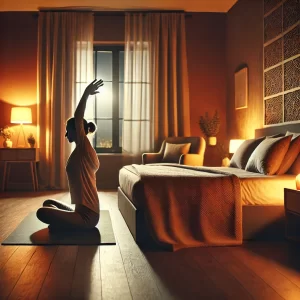
The Connection Between Yoga and Better Sleep

Yoga helps relax the body, calm the mind, and improve sleep quality naturally.
How Yoga Supports Better Sleep
Yoga’s power to enhance sleep stems from its holistic approach, benefiting both the body and mind. Let’s explore the key ways yoga fosters better sleep:
- Reduces Stress and Anxiety: Yoga activates the parasympathetic nervous system (the body’s “rest and digest” mode), reducing cortisol levels — the primary stress hormone. This helps calm the mind and prepares the body for restful sleep.
- Encourages Mindfulness: Yoga emphasizes being present and tuning into the body’s sensations, which can interrupt the racing thoughts that often prevent sleep.
- Relaxes Muscles: Gentle stretching releases physical tension, particularly in the neck, shoulders, and lower back — areas where stress tends to accumulate.
- Improves Breathing: Pranayama (breath control) enhances oxygen flow, slows heart rate, and promotes a sense of calm, which helps ease the transition into sleep.
Scientific Evidence Supporting Yoga for Sleep
Research increasingly supports yoga’s role in improving sleep. Studies show that people who practice yoga regularly report better sleep quality, fewer instances of insomnia, and reduced sleep disturbances. A 2017 study published in The Journal of Clinical Psychology found that yoga can improve sleep efficiency (the ratio of time asleep to time spent in bed), particularly in individuals experiencing chronic insomnia.
Another study highlighted yoga’s ability to increase melatonin production — the hormone responsible for regulating the sleep-wake cycle — and decrease nighttime awakenings. These findings reinforce that yoga isn’t just a relaxing activity; it’s a science-backed tool to promote deep, restorative sleep.
Best Types of Yoga for Sleep
Not all yoga styles are created equal when it comes to preparing for sleep. Some energizing forms like Vinyasa or Power Yoga are better suited for daytime practice. For nighttime, slower, gentler practices work best:
- Restorative Yoga: Focuses on supported poses held for several minutes, allowing muscles to fully relax.
- Yin Yoga: Targets deep connective tissues, encouraging physical and mental release.
- Hatha Yoga: A slower-paced style that combines basic postures with breath control to promote calmness.
- Yoga Nidra: Also known as “yogic sleep,” this guided meditation leads practitioners into a deeply relaxed, semi-conscious state — perfect for unwinding before bed.
Effective Yoga Poses to Promote Sleep
A bedtime yoga routine doesn’t need to be lengthy or complicated. A few calming poses can set the stage for restful sleep:
- Child’s Pose (Balasana): Gently stretch the lower back, hips, and thighs while promoting a sense of safety and calm.
- Legs Up the Wall (Viparita Karani): Elevating the legs encourages blood flow back to the heart, which slows the heart rate and soothes the nervous system.
- Reclining Butterfly (Supta Baddha Konasana): Opens the hips and chest, releasing built-up tension.
- Corpse Pose (Savasana): The ultimate relaxation pose, it encourages full-body surrender and mental stillness.
Breathing Techniques (Pranayama) for Better Sleep
Breathwork is a powerful component of yoga that supports better sleep by calming the mind and reducing physiological arousal. Here are a few techniques to incorporate:
- 4-7-8 Breathing: Inhale for 4 counts, hold for 7 counts, and exhale slowly for 8 counts. This pattern slows the heart rate and helps ease anxiety.
- Alternate Nostril Breathing (Nadi Shodhana): Balances the body’s energy channels, fostering a sense of equilibrium and calm.
- Bhramari (Bee Breath): Produces a gentle humming sound that vibrates through the head, creating a soothing effect on the mind.
Building a Sleep-Friendly Yoga Routine
Creating a nighttime yoga ritual doesn’t have to be complicated. A simple, 20-30 minute routine, blending gentle poses and breathwork, can work wonders for sleep. For best results, practice yoga about an hour before bed in a quiet, dimly lit space.
Here’s a sample sequence:
- 5 minutes: Gentle breathing exercises (e.g., 4-7-8 breathing).
- 10-15 minutes: A few relaxing poses, like Child’s Pose, Legs Up the Wall, and Reclining Butterfly.
- 5-10 minutes: Final relaxation in Savasana or a brief Yoga Nidra session.
Other Lifestyle Tips to Enhance Sleep
Yoga is a powerful sleep aid, but pairing it with other healthy habits can amplify its benefits. Encourage readers to:
- Stick to a consistent sleep schedule — even on weekends.
- Avoid screens (blue light disrupts melatonin production) at least 30 minutes before bed.
- Create a relaxing bedtime environment — dim lights, comfortable bedding, and a cool room temperature.
- Limit caffeine and heavy meals in the evening.
Conclusion: Yoga as a Long-Term Solution
Incorporating yoga into a nightly routine offers more than just improved sleep. It nurtures mental clarity, emotional balance, and physical relaxation — all essential for long-term health and vitality. For those struggling with restless nights, yoga presents a gentle, natural, and deeply restorative solution.
So, roll out the mat, take a deep breath, and let yoga guide you to a peaceful night’s sleep.